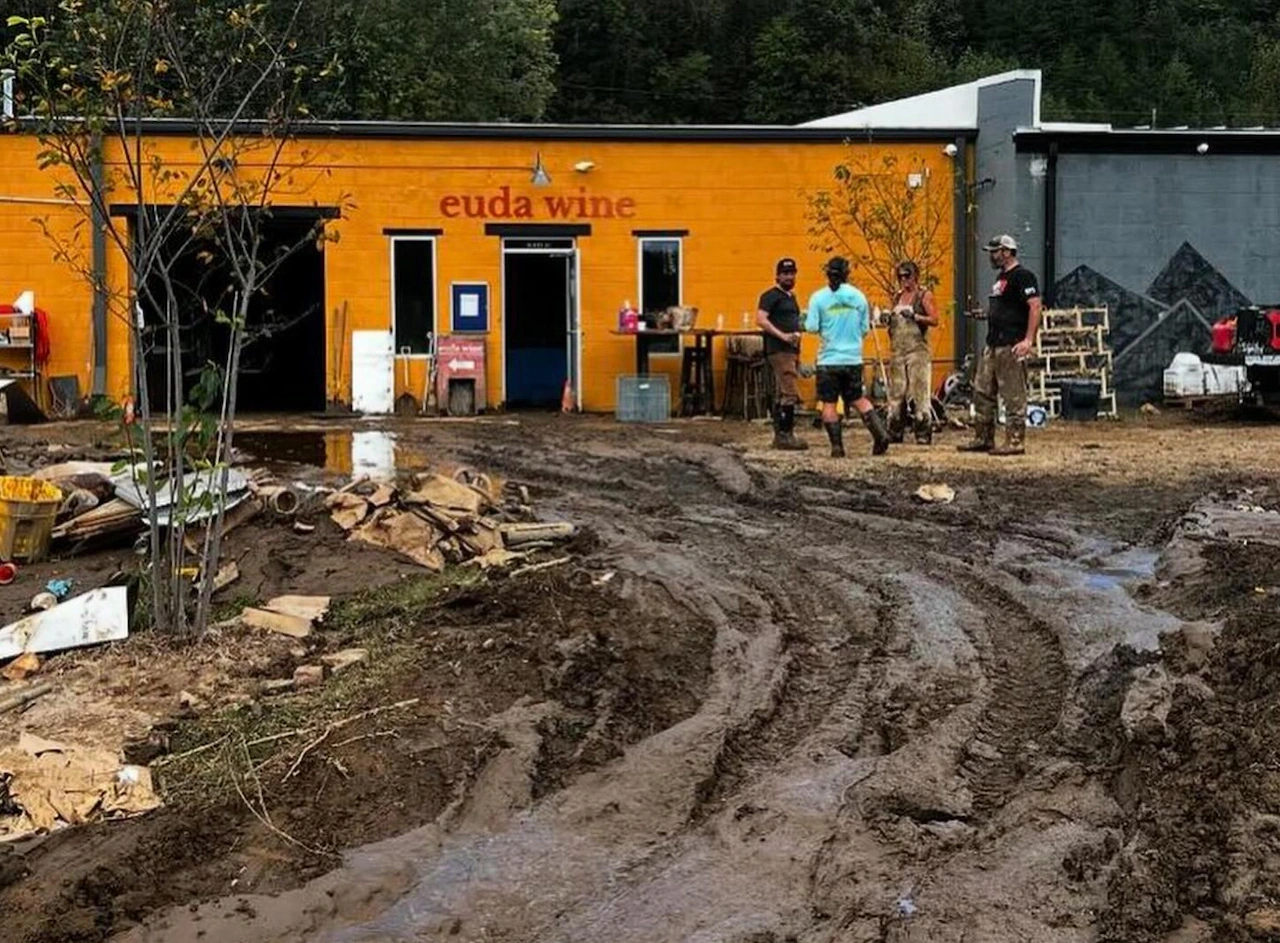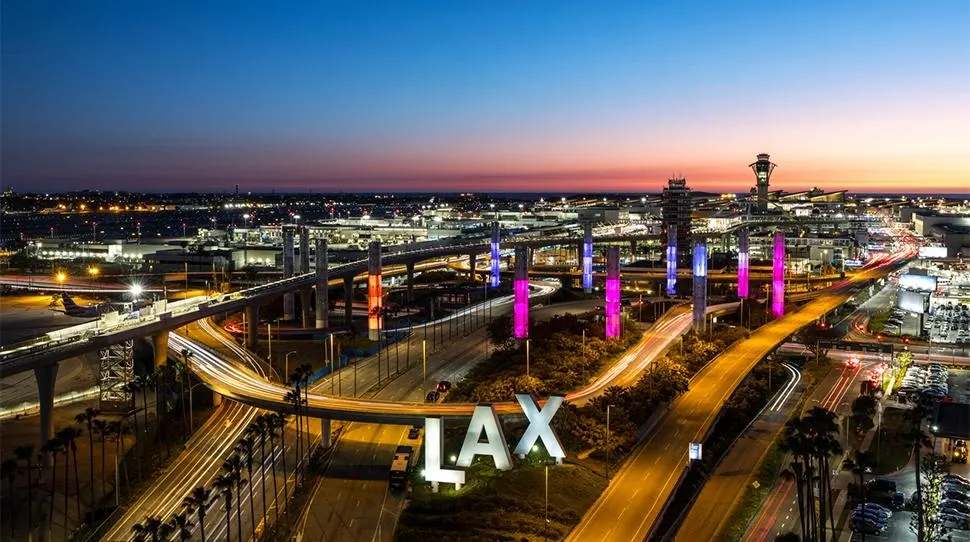
It was a year ago Friday that Cory Lillberg recalls awakening to a forecast of wind and rain from a weakening Hurricane Helene.
The co-owner and winemaker at Parker-Binns Vineyard in Mill Spring, North Carolina, in the foothills of the Blue Ridge Mountains, headed a couple of miles down the road and into town and watched the conditions begin to change.
“As I was driving back, there were literally pine trees falling into our main road, Highway 108, on either side of me, behind me,” he said during a phone conversation last week. “I’m watching it happen in my rearview mirror, and there’s other trees along the side of the road going down. I got home in the nick of time. I remember watching, first, the trees at my house, which is about a mile away from the vineyard. At the time, I lost five trees, Leyland cypress, in a matter of minutes. They just started dominoing all over the yard. Came to the farm, got in, noticed that we still had power. That only lasted about another hour, and it was gone. And once the power went out, it was just torrential downpour, crazy rain. I have a creek that runs right through the middle of my property into two ponds. That creek turned into a river, the two ponds turned into a lake. And I was in the winery watching just the madness outside.”
Helene turned into the worst disaster to hit western North Carolina in its history — based on the overall damage and fatalities — damaging many communities and ravaging that region’s economy. Many of the state’s more than 200 wineries were affected for varying lengths of time — a couple never reopened — but are still fighting the perception that it’s an area to still avoid.
For Lillberg, two memories stick out. One was focusing on taking good care of the active fermentations in the absence of power for more than a week and also the departure of winemaker Justin Taylor, whose home was damaged by two fallen trees, for longer than that, while he temporarily relocated his family to Atlanta. “So I was left making wine for Parker Binns and Marked Tree, who was our custom crush contract at the time. Really just trying to do it the old-fashioned way, because they’ve been making wine a long time before electricity.”
His other vivid memory, amid the cleanup and loss of all communication for more than a week, was the “9/11” mode that folks slipped into, producing an “obvious moment of teamwork that everybody just knew was what had to be done, because nobody was coming to help us in that moment. I remember people on golf carts riding up and down the highway trying to figure out if anybody needed anything. We had so many people come check on us, and we did the same in return.”
A year later, as the media starts cranking out the first anniversary story projects and videos, a majority of the wineries, including Parker-Binns, have found some normalcy while the region rebuilds.
Lillberg said that outside of some minor repairs, “we were aided in the fact that we are pretty well elevated here.” They did reopen within two weeks, although so many roads and bridges across western North Carolina were washed out or damaged that visitor traffic was greatly reduced during what is normally the busiest time of the year.
Hundreds of roads in western North Carolina remained closed or impassable after the storm, with the North Carolina DOT reporting 734 affected roads at one point. The heavy rain triggered numerous landslides and mudslides that blocked roads and destroyed parts of others, including a portion of I-40 connecting North Carolina and Tennessee and sections of the Blue Ridge Parkway.
Among the wineries that suffered significant damage were Pleb Urban Winery in Asheville, which was leveled by flooding and hasn’t opened since, Euda Wine in Old Fort and Souther Williams Vineyard in Fletcher, both closed for a significant length of time by water damage, and Burntshirt Vineyards tasting room in Chimney Rock, which has remained closed after the front section of the building collapsed.
In Chimney Rock, the town that provides a bit of civilization for those heading into or through the adjacent state park, more than half the buildings on Main Street were destroyed, and infrastructure such as power, water, sewer lines, and transportation roadways were largely obliterated.
A year later, the state park website still notes that the only open route into Chimney Rock is NC 9 through Lake Lure, with all other routes remaining closed to non-local traffic, including US 74A from Asheville, US 64 from Hendersonville, and NC 9 from Black Mountain. A few stores reopened this summer, albeit only a couple of days a week as cleanup and construction continue, all aimed toward a “grand reopening” in late 2026 or 2027.
“The river completely wiped out the entire town,” Lillberg said. “So it took all the bars, all the restaurants, all the shops. I mean, the river literally had to be put back, and that’s what they’re actively doing now.”
The overall damage to the economy reverberated from Chimney Rock to Hendersonville to Asheville, and beyond. Shortly after the storm, when former Gov. Roy Cooper told out-of-towners not to come to western North Carolina unless they were involved in the rescue effort, he showed a map and drew a line along U.S. 77. That included the foothills of the Piedmont (the Yadkin Valley AVA), which did not sustain the damage that the more mountainous areas sustained. While that area has recovered, several Piedmont winery owners told PennLive they are still trying to get the word out that they are fully open.
“The general message at that time was, stay away,” said Lillberg, who is also the secretary of the North Carolina Wine Growers Association (NCWGA) and represents the western section of the state. “We are such a tourism-driven industry, as you know, especially out here in western North Carolina. Because, sure, we have access to some of those larger markets, like Charlotte, Asheville, Greenville, but, you know, all of us, in some way, shape or form, were affected. So folks were just really staying home.
“And we certainly had a hard time generating the traffic that we would be used to seeing.”
Parker Binns sits on a 40-acre estate, with more than 12 acres supporting grapevines. He said the area received close to 30 inches of rain from the storm, but “thankfully had [picked] all of our fruit, and we were already in.” He has seen no residual effects in the vineyard this year, he said. “Where there were broken posts and things of that nature in the vineyard, those vines needed to be tugged out as they were compromised and had to be replanted. It wasn’t enough vines for me to sit here, honestly, and say it has a huge impact on our yield coming into this year. It was more so just, you know, PTSD, to some degree, you’re watching [this] August the way that it was, [where] it rained pretty much from Aug. 1 to the 21st non-stop.”
Parker-Binns Vineyard sits in the middle of a group of 65 mountain wine, cider and mead producers that stretch from Murphy near the Tennessee border, to Glade Valley near the Virginia-North Carolina line.
From Parker-Binns, it’s an 85-mile drive east to Charlotte, a 45-minute drive northwest to Asheville, and a 15-minute drive southwest to Tryon, near the South Carolina border. It’s open Wednesday through Sunday, with a relish kitchen complementing the wine with some food options beginning Thursday through the weekend.
Lillberg said that they saw business dip last fall and then rebound this year. He’s optimistic that next year will be even better.
“We’re just thankful at the end of the day to be able to open our doors every day,” he said. “And again, I thought back to COVID in the immediate aftermath of Helene. I remembered the vacuum when we had to close for COVID, and there was a tremendous vacuum created when we closed our doors. But then once we got the green light from Raleigh to reopen, there was a void that needed filled, and people were literally running out the door of their homes in the cities, whether that be Raleigh, Charlotte, Asheville, and coming out to the vineyards.
“But I do believe that when [Lake Lure] comes back and the official word from our senators in the state is grand reopening in 2027 of Chimney Rock, hopefully sooner, but that would be worst-case scenario, that people are also, just like COVID, are going to flood back to the area. I hope, anyway. That’s the optimist in me that that will be really positive for western North Carolina wineries, cideries, meaderies, you name it.”



